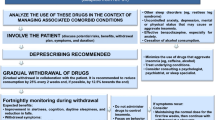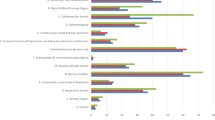Abstract
Background: The prolonged current survival of human immunodeficiency virus (HIV) patients exposes them to new problems arising from the comorbidities they face. Objectives: To describe the situation of comorbidities, polypharmacy, therapeutic complexity and adherence in people living with HIV over 65 years of age and to assess the presence of potentially inappropriate prescriptions (PIP) by applying deprescription criteria. Methods: Observational study including HIV people (> 65 years) from a university tertiary level hospital. Demographic, clinical and pharmacotherapeutic characteristics of the patients and their treatments were studied. The prevalence of polypharmacy (> 5 medications) and the pharmacotherapy complexity, quantified by the Medication Regimen Complexity Index (MRCI), were calculated. Therapeutic adherence was assessed by the Simplified Medication Adherence Questionnaire (SMAQ) and the medication possession ratio, according to prescription dispensing records. The Screening Tool of Older People’s Prescriptions (STOPP) and List of Evidence-baSed depreScribing for CHRONic patients (LESS-CHRON) criteria were applied to identify PIP. Main outcome measure: PIP in elderly people living with HIV. Results: Thirty patients were included, 73% of whom were men, with a median age of 71 years (IQR 67 − 76) and a median duration of infection of 17 years (IQR, 9 − 21). Seventy percent of the patients suffered from dyslipemia, 66.7% from hypertension, 43.3% from diabetes and 26.7% from mental health disorders. Seventy percent of the patients took more than 5 medications and 30% more than 10. The MRCI of concomitant medications was higher (18.3 points) than the MRCI of antiretroviral therapy (5.1 points), 66.7% of the studied population was classified as adherent. Finally, 70% of the patients present some PIP according to the STOPP or LESS-CHRON criteria. The polypharmacy was significantly associated (p = 0.008) with meeting deprescription criteria. Conclusion: The elderly people living with HIV present numerous comorbidities and met the criteria for polypharmacy. Their pharmacotherapy complexity is mainly determined by the concomitant treatments. There is a high prevalence of meeting deprescription criteria in people living with HIV over the age of 65 and a clear relationship between polypharmacy and deprescription. The optimization of pharmacotherapy is necessary in this population.


Similar content being viewed by others
References
Collaboration ATC. Survival of HIV-positive patients starting antiretroviral therapy between 1996 and 2013: a collaborative analysis of cohort studies. Lancet HIV. 2017;4(8):349–56.
Gimeno-Gracia M, Crusells-Canales MJ, Rabanaque-Hernández MJ. Clinical characteristics and antiretroviral treatment of older HIV-infected patients. Int J Clin Pharm. 2014;36:1190–5.
Blanco JR, Jarrín I, Vallejo M, Berenguer J, Solera C, Rubio R, et al. CoRIS. Definition of advanced age in HIV infection: looking for an age cut-off. AIDS Res Hum Retroviruses. 2012;28(9):1000–6.
Brañas F, Berenguer J, Sánchez-Conde M, López-B. Quirós JC, Miralles P, Cosín J, et al. The eldest of older adults living with HIV: response and adherente to highly active antiretroviral therapy. Am J Med. 2008;121:820–4.
Guaraldi G, Orlando G, Zona S, Menozzi M, Carli F, Garlassi E, et al. Premature age-related comorbidities among HIV-infected persons compared with the general population. Clin Infect Dis. 2011;53(11):1120–6.
Reid E, Suneja G, Ambinder RF, et al. Cancer in People Living With HIV, Version 1.2018, NCCN Clinical Practice Guidelines in Oncology. J Natl Compr Canc Netw. 2018;16(8):986–1017.
Manzano-García M, Robustillo-Cortés A, Almeida-Gonzalez CV, Morillo-Verdugo R. Evolution of the Complexity Index of the antiretroviral therapy in HIV+ patients in a real-life clinical practice. Rev Española Quimioter. 2017;30(6):429–35.
George J, Phun YT, Bailey MJ, Kong DCM, Stewart K. Development validation of the medication regimen complexity index. Ann Pharmacother. 2004;38(9):1369–76.
Wimmer BC, Bell JS, Fastborn J, Wiese MD, Johnell K. Medication regimen com- plexity and polypharmacy as factors associated with all-cause mortality in older people: a population-based cohort study. Ann Pharmacother. 2016;50(4):89–95.
Maher RL, Hanlon J, Hajjar ER. Clinical consequences of polypharmacy in elderly. Expert Opin Drug Saf. 2014;13(1):57–65.
Rodríguez Pérez A, Alfaro Lara ER, Nieto Martín MD, Ruiz Cantero A, Santos RB. Deprescribing in patients with multimorbidity: a necessary process. Eur J Intern Med. 2015;26:18–9.
Delgado Silveira E, Montero Errasquín B, Muñoz García M, Vélez-Díaz-Pallarés M, Lozano Montoya I, Sánchez-Castellano C, et al. [Improving drug prescribing in the elderly: a new edition of STOPP/START criteria]. Rev Esp Geriatr Gerontol. 2015; 50(2): 89–96.
Pastor Cano J, Aranda García A, Gascón Cánovas JJ, Rausell Rausell VJ, Tobaruela SM. Spanish adaptation of the Beers criteria. An Sist Sanit Navar. 2015;38(3):375–85.
Rodríguez-Pérez A, Alfaro-Lara ER, Albiñana-Perez S, Nieto-Martín MD, Díez-Manglano J, Pérez-Guerrero C, et al. Novel tool for deprescribing in chronic patients with multimorbidity: List of Evidence-Based Deprescribing for Chronic Patients criteria. Geriatr Gerontol Int. 2017;17(11):2200–7.
McNicholl IR, Gandhi M, Hare CB, Greene M, Pierluissi E. A Pharmacist-Led Program to Evaluate and Reduce Polypharmacy and Potentially Inappropriate Prescribing in Older HIV-Positive Patients. Pharmacotherapy. 2017;37(12):1498–506.
Modelo de Selección y Atención Farmacéutica a Pacientes Crónicos de la Sociedad Española de Farmacia Hospitalaria [Access 16–6–18]. Available at: http://www.sefh.es/bibliotecavirtual/Cronicos/AF_INFORME_PACIENTE_GESTION_SANITARIA.pdf
Morillo-Verdugo R, Martínez-Sesmero JM, Lázaro-López A, Sánchez-Rubio J, Navarro-Aznárez H, DeMiguel-Cascón M. Development of a risk stratification model for pharmaceutical care in HIV patients. Desarrollo de un modelo de estratificación de atención farmacéutica destinado a pacientes VIH. Farm Hosp. 2017;41(3):346–56.
Greene M, Steinman MA, McNicholl IR, Valcour V. Polypharmacy, drug-drug interactions, and potentially inappropriate medications in older adults with human immunodeficiency virus infection. J Am Geriatr Soc. 2014;62(3):447–53.
Haider SI, Johnell K, Weitoft GR, Thorslund M, Fastbom J. The influence of educational level on polypharmacy and inappropriate drug use: a register-based study of more than 600,000 older people. J Am Geriatr Soc. 2009;57(1):62–9.
Saez de la Fuente J, Such Diaz A, Cañamares-Orbis I, et al. Cross-cultural Adaptation and Validation of the Medication Regimen Complexity Index Adapted to Spanish. Ann Pharmacother. 2016;50(11):918–25.
Panel de Expertos de GeSIDA, Sociedad Española de Farmacia Hospitalaria (SEFH), Plan Nacional sobre el Sida (PNS). Recomendaciones GESIDA/SEFH/PNS para mejorar la adherencia al tratamiento antirretroviral. [Actualización junio 2008]. [Access 15–6–18]. Available at: http://gesida-seimc.org/wp-content/uploads/2017/02/Gesida_dcyrc2008_adherenciaTAR.pdf
Bangsberg DR. Less than 95% adherence to nonnucleoside reverse-transcriptase inhibitor therapy can lead to viral suppression. Clin Infect Dis. 2006;43(7):939–41.
Page AT, Clifford RM, Potter K, Schwartz D, Etherton-Beer CD. The feasibility and effect of deprescribing in older adults on mortality and health: a systematic review and meta-analysis. Br J Clin Pharmacol. 2016;82(3):583–623.
Moltó J, Miranda C, Malo S, Valle M, Andreu A, Bonafont X, et al. Use of herbal remedies among HIV-infected patients: patterns and correlates. Med Clin (Barc). 2012;138(3):93–8.
Tannenbaum C, Martin P, Tamblyn R, Benedetti A, Ahmed S. Reduction of inappropriate benzodiazepine prescriptions among older adults through direct patient education: The EMPOWER cluster randomized trial. JAMA Intern Med. 2014;174(6):890–8.
Nozza S, Malagoli A, Maia L, Calcagno A, Focà E, De Socio G, et al. Antiretroviral therapy in geriatric HIV patients: The GEPPO cohort study. J Antimicrob Chemother. 2017;72(10):2879–86.
Metz KR, Fish DN, Hosokawa PW, Hirsch JD, Libby AM. Patient-Level Medication Regimen Complexity in Patients With HIV. Ann Pharmacother. 2014;48(9):1129–37.
Calvo-Cidoncha E, González-Bueno J, Almeida-González CV, Morillo-Verdugo R. Influence of treatment complexity on adherence and incidence of blips in HIV/HCV coinfected patients. J Manag Care Spec Pharm. 2015;21(2):153–7.
Robustillo Cortés MLA, Morillo Verdugo R, Barreiro Fernández EM, Pavón Plata A, Monje AP. Influence of hospital admission in the pharmacotherapy complexity of HIV+ patients. Farm Hosp. 2017;41(4):518–26.
Cantudo-Cuenca MR, Jiménez-Galán R, Almeida-Gonzalez CV, Morillo-Verdugo R. Concurrent use of comedications reduces adherence to antiretroviral therapy among HIV-infected patients. J Manag Care Spec Pharm. 2014;20:844–50.
Gimeno-Gracia M, Sánchez-Rubio-Ferrández J, Robustillo-Cortés MLA, Morillo-Verdugo R. Prevalencia de polifarmacia y complejidad farmacoterapéutica en personas mayores con VIH en España. Estudio POINT Farm Hosp. 2020;44(4):127–34.
Acknowledgements
We thank Mercedes Gimeno and Sara Malo for the final manuscript. We would especially like to thank all the people that participated in this study.
Funding
There has not been any funding for this study.
Author information
Authors and Affiliations
Corresponding author
Ethics declarations
Conflicts of interest
On behalf of all authors, the corresponding author states that there is no conflict of interest.
Additional information
Publisher's Note
Springer Nature remains neutral with regard to jurisdictional claims in published maps and institutional affiliations.
Rights and permissions
About this article
Cite this article
Vinuesa-Hernando, J.M., Gimeno-Gracia, M., Malo, S. et al. Potentially inappropriate prescriptions and therapeutic complexity in older HIV patients with comorbidities. Int J Clin Pharm 43, 1245–1250 (2021). https://doi.org/10.1007/s11096-021-01242-1
Received:
Accepted:
Published:
Issue Date:
DOI: https://doi.org/10.1007/s11096-021-01242-1




